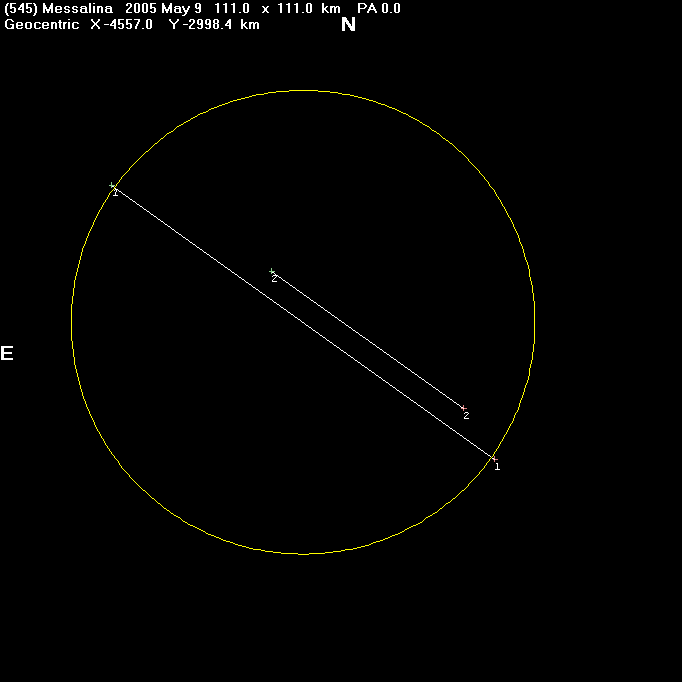An approximately 19 second occultation was reported by Brian Loader in Darfield, NZ, and an approximately 10.5 second occultation by Clive Rowe in Waddington, not far away. However timings in each case were affected by the poor observing conditions.
View the updated prediction.
Observers: 1 B. Loader, Darfield, NZ 2 C. Rowe, Waddington, NZ

The circle represents the predicted 111 km diameter of Messalina.
Discussion:
This occultation was observed from two relatively close sites - Brian Loader in Darfield, NZ, and Clive Rowe in Waddington, NZ. Both observers reported that the star could only be seen by averted vision, and that this has significantly affected their timings. (See observers' comments below). This is further borne out by the fact that the two very different chord lengths, reported this close together, cannot represent a true cross-section across the asteroid.
Unfortunately, while both observers were positive about seeing an event, the times are so uncertain as to make it impossible to derive any additional information about the minor planet.
Observational Data:
Observer's Name : Brian Loader
Aperture (cm) : 25.4
Focal length (cm) : 250
Type (e.g. SCT; Newtonian) : SCT
Magnification : 80x
Observing site name : Darfield
Longitude (DD MM SS ; East +ve) : +172° 06' 24.4" E
Latitude (DD MM SS ; South -ve) : -43° 28' 52.9" S
Height above Sealevel (metres) : 210
Geodetic Datum (e.g.WGS84,NZ1949): WGS84
Height Datum (if known) : MSL
Sky Transparency (Delete two) : Good
Star Image Stability (Delete two): Fair
Other Conditions:
(Wind, Clouds, Lights, etc.): nil
Time Source (e.g. WWVH, GPS) : GPS
Recording method (e.g. tape) : KIWI/Computer
Could you see the Asteroid? : no
Approx. Limiting Magnitude : 13
| Estimated |
Universal Time | Reaction | Accuracy, Remarks
h m s | Time (sec) |
Started Observing : 09:25:20
Disappearance At : 09:27:15 1.7 subtracted very approximate
Reappearance At : 09:27:34 2.0 subtracted possibly late, see notes
Stopped Observing : 09:28:45
Was your reaction time (also known as Personal Equation) subtracted from
any of the above timings? : yes
If YES, state value : as above
ADDITIONAL COMMENTS:
Visual observation by averted vision. Times are very approximate, the PE used are partly to round off
to a second. In view of Clive Rowe's report, it seems quite likely I missed the reappearance altogether.
In all honesty, I think that all that can be said is that an event occurred, and that it probably
started at about the predicted time for the mid event. Also, in the light of Clive's report, it may
have been considerably shorter than the predicted maximum duration of 19.2 seconds.
Observer's Name : Clive Rowe
Aperture (cm) : 33 cm
Focal length (cm) : 150 cm
Type (e.g. SCT; Newtonian) : Newtonian / non-driven equatorial
Magnification : 60 x
Observing site name : Waddington
Longitude (DD MM SS ; East +ve) : +172 02 02
Latitude (DD MM SS ; South -ve) : -43 23 58
Height above Sealevel (metres) : 300
Geodetic Datum (e.g.WGS84,NZ1949): Garmin GPS
Height Datum (if known) :
Sky Transparency (Delete two) : Good
Star Image Stability (Delete two): Fair
Other Conditions:
(Wind, Clouds, Lights, etc.): Clear night, light wind
Time Source (e.g. WWVH, GPS) : WWVH
Recording method (e.g. tape) : WWVH aural count plus stopwatch (no tape)
Could you see the Asteroid? : No
Approx. Limiting Magnitude : 12.5
| Estimated |
Universal Time | Reaction | Accuracy, Remarks
h m s | Time (sec) |
Started Observing : 09:20 Started field identification approx - 1 hour prior occ
Star and Object Merged : na (not applicable, asteroid not visible)
Disappearance At approx : 09:27:18 (lost count of WWVH time, no tape recorder)
Estimated Closest Approach : na
Reappearance At : watch was stopped, reading 9.5 seconds with about 1 sec delay
Star and Object Separated :
Stopped Observing : 09:29 (target still visible 09:50)
Was your reaction time (also known as Personal Equation) subtracted from
any of the above timings? : Yes: >2 second at ingress delayed by check on visibility by averted vision,
approx. 1 second delay on egress
Hence occultation DURATION: 9.5 + >2 -1 = >10.5 seconds.
error. est >2 and -1 seconds
ADDITIONAL COMMENTS: This was (again) a marginal observation as averted vision was used to see
the target star and this produced additional delays in timing. In my (1/2 deg.) field, the star
just above the target was used to guide the averted vision position. My estimate of ingress time
was 09:27:18 but this may have been late.
[Top of Page][Return to Home Page]